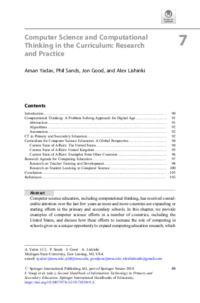Computer Science and Computational Thinking in the CurriculumResearch and Practice
Zu finden in: Second Handbook of Information Technology in Primary and Secondary Education (Seite 89 bis 106), 2018
  |
 |
 Diese Seite wurde seit 1 Jahr inhaltlich nicht mehr aktualisiert.
Unter Umständen ist sie nicht mehr aktuell.
Diese Seite wurde seit 1 Jahr inhaltlich nicht mehr aktualisiert.
Unter Umständen ist sie nicht mehr aktuell.
 Zusammenfassungen
Zusammenfassungen
 Computer science education, including computational thinking, has received considerable attention over the last few years as more and more countries are expanding or starting efforts in the primary and secondary schools. In this chapter, we provide examples of computer science efforts in a number of countries, including the United States, and discuss how these efforts to increase the role of computing in schools gives us a unique opportunity to expand computing education research, which has significantly lagged the rapid growth of computer science. We have laid out directions for future research under two broad areas of teaching training and student learning. Specifically, we discuss potential research areas around knowledge teachers need to teach computing ideas and factors that influence students learning to program.
Computer science education, including computational thinking, has received considerable attention over the last few years as more and more countries are expanding or starting efforts in the primary and secondary schools. In this chapter, we provide examples of computer science efforts in a number of countries, including the United States, and discuss how these efforts to increase the role of computing in schools gives us a unique opportunity to expand computing education research, which has significantly lagged the rapid growth of computer science. We have laid out directions for future research under two broad areas of teaching training and student learning. Specifically, we discuss potential research areas around knowledge teachers need to teach computing ideas and factors that influence students learning to program.“The child programs the computer and, in doing so, both acquires a sense of mastery over a piece of the most modern and powerful technology and establishes an intimate contact with some of the deepest ideas from science, from mathematics, and from the art of intellectual model building” – Seymour Papert
 Dieses Kapitel erwähnt ...
Dieses Kapitel erwähnt ...
 Personen KB IB clear | Susan Bergin , Ulf Dalvad Berthelsen , Steve Cooper , Mark Dorling , Richard J. Enbody , Jon Good , Susanne E. Hambrusch , Simon Humphreys , John T. Korb , Alex Lishinski , Chris Mayfield , Briana B. Morrison , Seymour Papert , Ronan Reilly , Sue Sentance , The Royal Society , Desmond Traynor , Susan Wiedenbeck , Jeannette M. Wing , Aman Yadav , Ninger Zhou | ||||||||||||||||||||||||||||||||||||||||||||||||||||||||||||||||||||||||||||||||||||||||||
 Begriffe KB IB clear | computational thinkingcomputational thinking
, Informatikcomputer science
, Informatik-Unterricht (Fachinformatik)Computer Science Education
,  Mathematik Mathematik mathematics mathematics
| ||||||||||||||||||||||||||||||||||||||||||||||||||||||||||||||||||||||||||||||||||||||||||
 Bücher |
| ||||||||||||||||||||||||||||||||||||||||||||||||||||||||||||||||||||||||||||||||||||||||||
 Texte |
|
 Dieses Kapitel erwähnt vermutlich nicht ...
Dieses Kapitel erwähnt vermutlich nicht ... 
 Nicht erwähnte Begriffe | Informatik-Didaktik, Informatikunterricht in der Schule |
 Tagcloud
Tagcloud
 Zitationsgraph
Zitationsgraph
 Zitationsgraph (Beta-Test mit vis.js)
Zitationsgraph (Beta-Test mit vis.js)
 Zeitleiste
Zeitleiste
 3 Erwähnungen
3 Erwähnungen 
- Digitale Bildung im Grundschulalter - Grundsatzfragen zum Primat des Pädagogischen (Mareike Thumel, Rudolf Kammerl, Thomas Irion) (2020)

- Digitale Grundbildung in der Grundschule - Grundlegende Bildung in der digital geprägten und gestaltbaren, mediatisierten Welt (Thomas Irion)

- Digitale Grundbildung in der Grundschule - Grundlegende Bildung in der digital geprägten und gestaltbaren, mediatisierten Welt (Thomas Irion)
- WiPSCE '20 - Workshop in Primary and Secondary Computing Education, Virtual Event, Germany, October 28-30, 2020 (Torsten Brinda, Michal Armoni) (2020)
- Exploring the K-12 computer science curriculum standards in the U.S (Meize Guo, Anne T. Ottenbreit-Leftwich) (2020)


- Exploring the K-12 computer science curriculum standards in the U.S (Meize Guo, Anne T. Ottenbreit-Leftwich) (2020)
- Teaching Coding in K-12 Schools - Research and Application (Therese Keane, Andrew Fluck) (2023)


- Computational Thinking in Pre-vocational Education - A Focus on Coding Unplugged (Diane van der Linde-Koomen, Herma Jonker, Joke Voogt)


- Computational Thinking in Pre-vocational Education - A Focus on Coding Unplugged (Diane van der Linde-Koomen, Herma Jonker, Joke Voogt)
 Anderswo finden
Anderswo finden
 Volltext dieses Dokuments
Volltext dieses Dokuments
 |  Computer Science and Computational Thinking in the Curriculum: Research and Practice: Artikel als Volltext bei Springerlink ( Computer Science and Computational Thinking in the Curriculum: Research and Practice: Artikel als Volltext bei Springerlink ( : :  , 288 kByte; , 288 kByte;  : :  ) ) |
 Anderswo suchen
Anderswo suchen 
 Beat und dieses Kapitel
Beat und dieses Kapitel
Beat hat Dieses Kapitel während seiner Zeit am Institut für Medien und Schule (IMS) ins Biblionetz aufgenommen. Beat besitzt kein physisches, aber ein digitales Exemplar. Eine digitale Version ist auf dem Internet verfügbar (s.o.). Es gibt bisher nur wenige Objekte im Biblionetz, die dieses Werk zitieren.



















 Biblionetz-History
Biblionetz-History